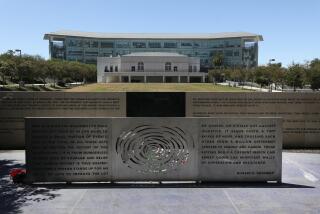A Bleak View on New Schools
Environmental problems like those that caused the Belmont Learning Complex to be abandoned may make it impossible to build any schools in the downtown area and require some schools to be closed, according to Los Angeles Board of Education President Genethia Hayes.
Hayes said the district may have to bus more students out of the crowded downtown area, or come up with creative solutions such as converting office space to classrooms.
In making her comments--first on a radio show Monday and in an interview with The Times on Tuesday--Hayes took a stance on school safety that goes far beyond anything previously discussed by the board or public health officials.
Some board members disagreed with her assessment of the situation.
“I’m probably making everybody at LAUSD nervous, but we have to do what’s right by those kids,” Hayes said Tuesday. “I think it’s a nightmare.”
Her statements put her at odds with the district’s current plan to build about 100 schools over the next five years, including dozens of schools in the downtown area. The goal is to eliminate busing as a means of alleviating overcrowding and to accommodate projected enrollment growth.
After that, Supt. Roy Romer hopes to build more campuses so the district can eliminate year-round calendars at hundreds of schools.
School officials have identified dozens of potential school sites throughout the district. Since the board killed the Belmont complex in January, that area has been its highest priority. Now, thousands of students are bused each day to other parts of the city because of overcrowding at all grade levels.
Several sites in the downtown area have been dropped from the five-year plan because of environmental contamination. Planners are deferring those sites to the long-term plan, assuming that there will be more time to clean them.
Many people inside and outside the district believe the nearly completed Belmont complex could be made safe for a school. They have long argued that it was being held to a standard of environmental purity that other sites could not meet.
Acknowledging that she was speaking only for herself, Hayes said on the radio show “Which Way L.A.” that the solution should be to raise standards for all facilities--both future and existing--to a level exceeding the current levels considered acceptable for people living in their own homes.
“There are probably schools that were built before the time we knew medically about these things or that we had the technology to detect what we were building on top of,” Hayes said.
She specifically cited the existing Belmont High School, whose 4,600 students would have moved to the new Belmont had it been completed.
“I’d be willing to bet you that probably the kids who are at the Belmont school that is open right now should probably not be at that school,” she said.
The school is built above the same oil field as its replacement, which the school board abandoned over concern about explosive methane and toxic hydrogen sulfide.
Romer declined to comment on Hayes’ remarks, which caught other board members by surprise.
Board member Caprice Young, who voted to kill Belmont, said she is confident the district can build schools on contaminated sites. The problem with Belmont, she said, was that the district mishandled the environmental assessments. The district has since built a strong environmental team, Young said.
“Of course we’re going to build schools in the inner city,” Young said. “We have kids in the inner city.”
Board member Victoria Castro, who supports completing the new Belmont, said she found the comments irresponsible because Hayes made no attempt to convey her concerns to the affected communities.
“If community members heard that, it implies that children are in danger,” yet she has received no such information, Castro said.
Castro said parents argued that the new Belmont could be made safe because the old Belmont was built on the same oil field and “there had been no problem throughout its history.”
Hayes made her initial comments while debating the future of Belmont with Robert Garcia, president of the citizens committee that oversees the district’s $2.4-billion school repair and construction bond.
Today the committee is scheduled to consider a proposal to withhold money from future school construction until the board agrees to complete environmental studies under state supervision to determine if the site could be made safe.
More to Read
Sign up for Essential California
The most important California stories and recommendations in your inbox every morning.
You may occasionally receive promotional content from the Los Angeles Times.











